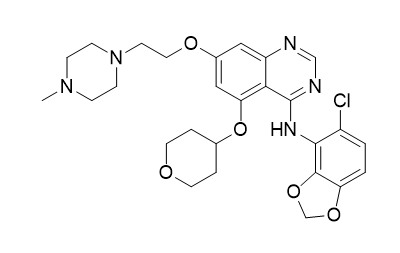Saracatinib (AZD0530)
Saracatinib (AZD0530) is a potent Src inhibitor with IC50 of 2.7 nM in cell-free assays, and potent to c-Yes, Fyn, Lyn, Blk, Fgr and Lck; less active for Abl and EGFR (L858R and L861Q). Saracatinib induces autophagy.
Inquire / Order:
manager@chemfaces.com
Technical Inquiries:
service@chemfaces.com
Tel:
+86-27-84237783
Fax:
+86-27-84254680
Address:
1 Building, No. 83, CheCheng Rd., Wuhan Economic and Technological Development Zone, Wuhan, Hubei 430056, PRC
Providing storage is as stated on the product vial and the vial is kept tightly sealed, the product can be stored for up to
24 months(2-8C).
Wherever possible, you should prepare and use solutions on the same day. However, if you need to make up stock solutions in advance, we recommend that you store the solution as aliquots in tightly sealed vials at -20C. Generally, these will be useable for up to two weeks. Before use, and prior to opening the vial we recommend that you allow your product to equilibrate to room temperature for at least 1 hour.
Need more advice on solubility, usage and handling? Please email to: service@chemfaces.com
The packaging of the product may have turned upside down during transportation, resulting in the natural compounds adhering to the neck or cap of the vial. take the vial out of its packaging and gently shake to let the compounds fall to the bottom of the vial. for liquid products, centrifuge at 200-500 RPM to gather the liquid at the bottom of the vial. try to avoid loss or contamination during handling.
J Sci Food Agric.2017, 97(5):1656-1662
Biomed Chromatogr.2020, e5021.
Nat Prod Communications2018, 10.1177
Plants (Basel).2021, 10(2):278.
Korea Food Research Institute2024, 4798082
Molecules.2021, 26(19):6032.
iScience.2024, 4790628.
J Agric Food Chem.2018, 66(1):351-358
Front Pharmacol.2020, 11:683.
Pharmaceuticals (Basel).2024 Feb 24;17(3):292.
Related and Featured Products
Mol Cancer Res,2009 Apr;7(4):476-88.
The Src inhibitor AZD0530 reversibly inhibits the formation and activity of human osteoclasts.[Pubmed:
19372577]
Tumor cells in the bone microenvironment are able to initiate a vicious cycle of bone degradation by mobilizing osteoclasts, multinucleated cells specialized in bone degradation. c-Src is highly expressed both in tumors and in osteoclasts. Therefore, drugs like AZD0530, designed to inhibit Src activity, could selectively interfere with both tumor and osteoclast activity.
METHODS AND RESULTS:
Here we explored the effects of AZD0530 on human osteoclast differentiation and activity. The effect on osteoclasts formed in vivo was assessed in mouse fetal calvarial explants and in isolated rabbit osteoclasts, where it dose-dependently inhibited osteoclast activity. Its effect on formation and activity of human osteoclasts in vitro was determined in cocultures of human osteoblasts and peripheral blood mononuclear cells. AZD0530 was most effective in inhibiting osteoclast-like cell formation when present at the onset of osteoclastogenesis, suggesting that Src activity is important during the initial phase of osteoclast formation. Formation of active phosphorylated c-Src, which was highly present in osteoclast-like cells in cocultures and in peripheral blood mononuclear cell monocultures, was significantly reduced by AZD0530. Furthermore, it reversibly prevented osteoclast precursor migration from the osteoblast layer to the bone surface and subsequent formation of actin rings and resorption pits.
CONCLUSIONS:
These data suggest that Src is pivotal for the formation and activity of human osteoclasts, probably through its effect on the distribution of the actin microfilament system. The reversible effect of AZD0530 on osteoclast formation and activity makes it a promising candidate to temper osteoclastic bone degradation in bone diseases with enhanced osteoclast activity such as osteolytic metastatic bone disease.
Mol Oncol,2009 Jun;3(3):248-61.
Preclinical anticancer activity of the potent, oral Src inhibitor AZD0530.[Pubmed:
19393585]
METHODS AND RESULTS:
AZD0530, an orally available Src inhibitor, demonstrated potent antimigratory and anti-invasive effects in vitro, and inhibited metastasis in a murine model of bladder cancer. Antiproliferative activity of AZD0530 in vitro varied between cell lines (IC(50) 0.2 ->10μM). AZD0530 inhibited tumor growth in 4/10 xenograft models tested and dynamically inhibited in vivo phosphorylation of Src substrates paxillin and FAK in both growth-inhibition-resistant and -sensitive xenografts. The activity of AZD0530 in NBT-II bladder cancer cells in vitro was consistent with inhibition of cell migration and stabilization of cell-cell adhesion.
CONCLUSIONS:
These data suggest a dominant anti-invasive pharmacology for AZD0530 that may limit tumor progression in a range of cancers. AZD0530 is currently in Phase II clinical trials.
Oncogene,2008 Oct 23;27(49):6365-75.
Src family kinase oncogenic potential and pathways in prostate cancer as revealed by AZD0530.[Pubmed:
18679417]
Cell lines:PC3, DU145, CWR22Rv1, LNCaP, LAPC-4, PZ-HPV7 and RWPE-1 cells
Concentrations: 62.5 nM - 16 mM
Incubation Time: 1, 3 and 5 days
Method:
Cells are seeded at a density of 2× 103 in 96-well plates and incubated overnight. Then Saracatinib (62.5 nM-16 mM) is added to the cells. After 1, 3 and 5 days, culture medium is removed followed by addition of 0.2 mL DMSO per well and continuous shaking of plates at 200 rotations per minute for 15min. Then IC50 is measured by MTT metho.
Oncogene,2008 Oct 23;27(49):6365-75.
Src family kinase oncogenic potential and pathways in prostate cancer as revealed by AZD0530.[Pubmed:
18679417]
Animal Models: CB17 mice are implanted with DU145 cells.
Dosages:25 mg/kg
Administration: Orally administered daily



